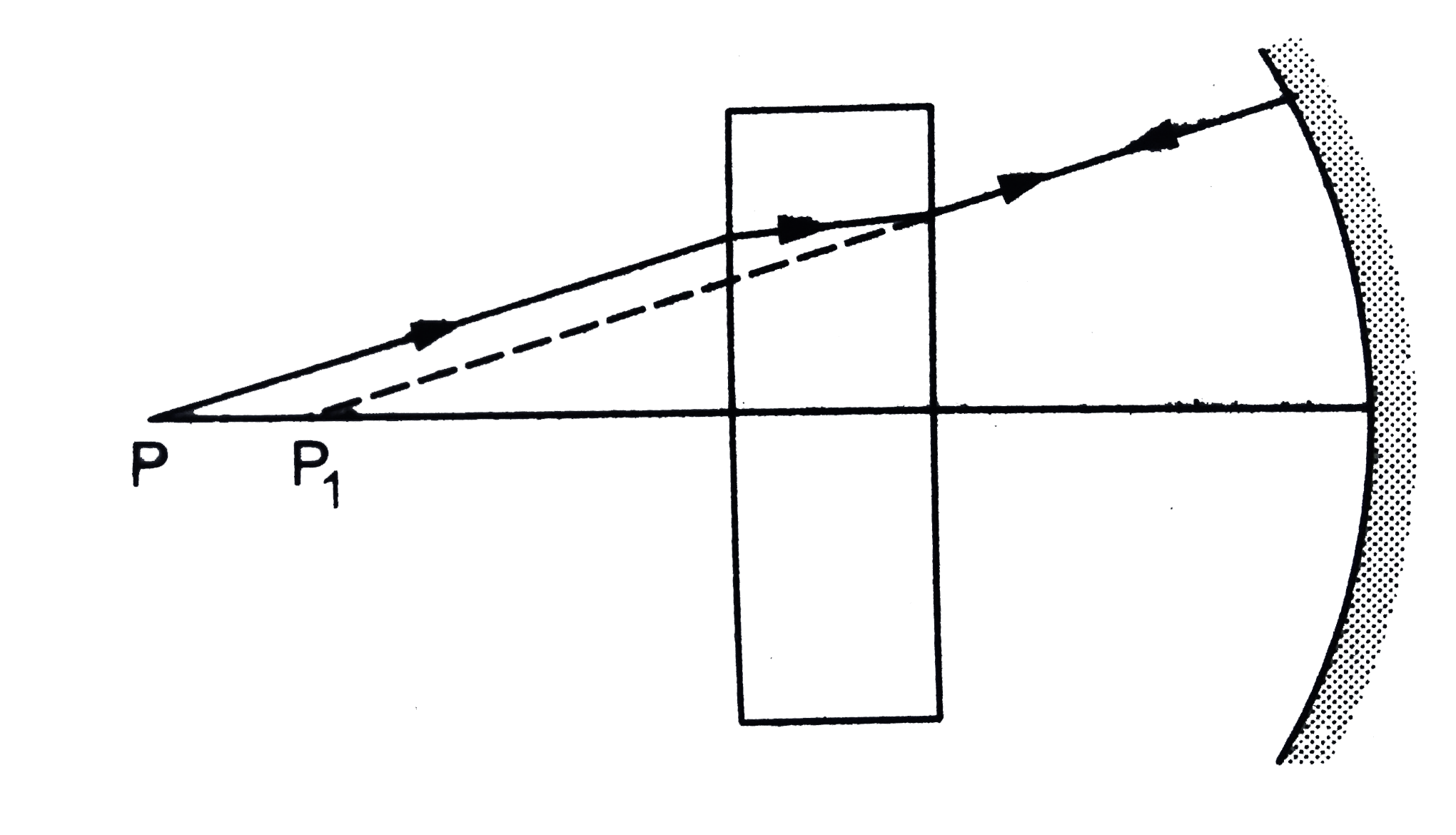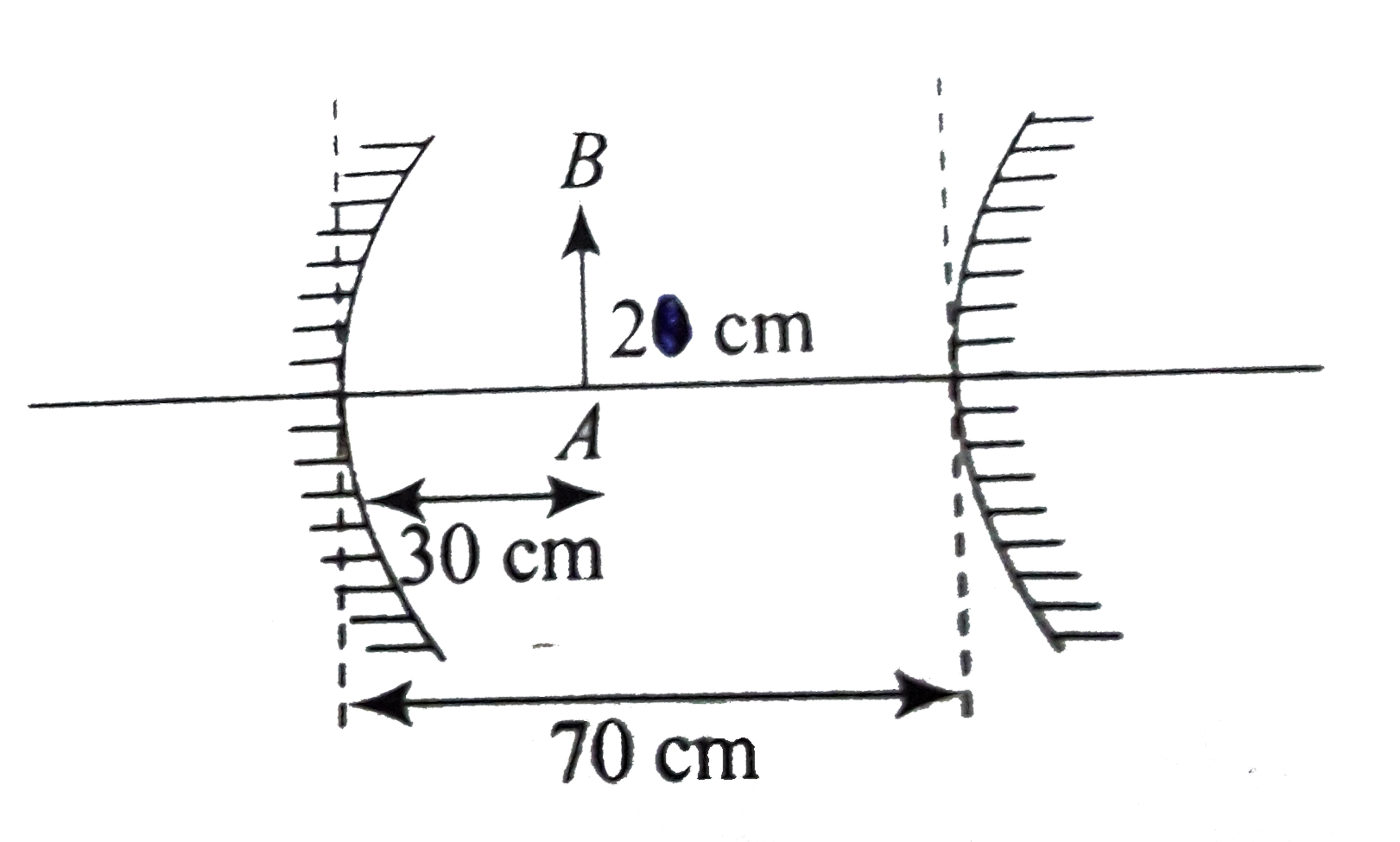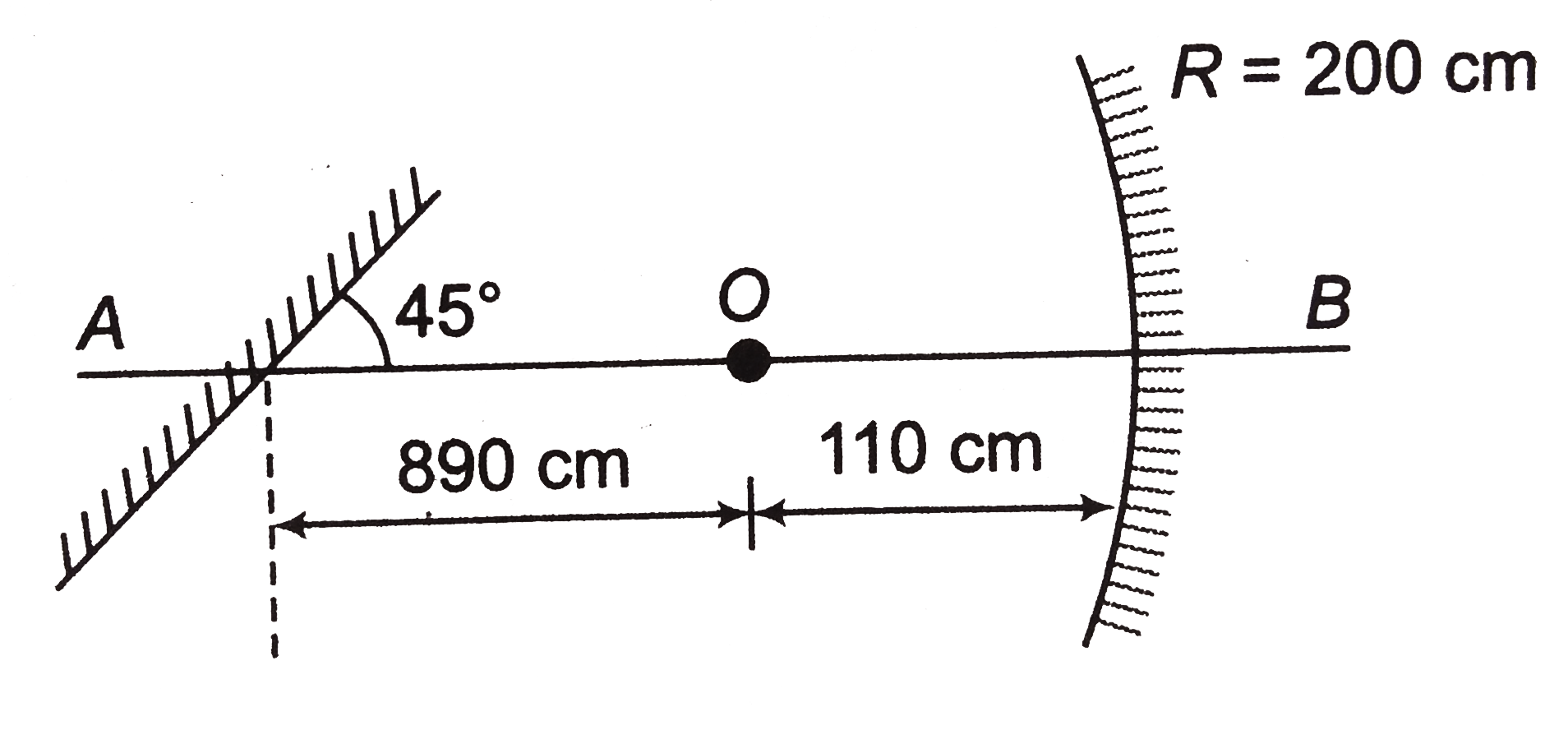A convex and a concave mirror of radii 10 cm are placed facing each other and 15 cm apart. An object is placed exactly between them. If the reflection first takes place in concave and then in convex mirror the position of the final image will be
7 cm behind concave mirror
at the pole of the concave mirror
at the pole of the convex mirror
6.7 cm in front of concave mirror
The correct Answer is:C
To solve the problem step by step, we will follow the principles of ray optics, specifically the mirror formula and the behavior of concave and convex mirrors.
Step 1: Understand the Setup
We have a concave mirror and a convex mirror, both with a radius of curvature (R) of 10 cm. The distance between the two mirrors is 15 cm. The focal length (F) of a mirror is given by the formula:
F=R2
Thus, for both mirrors:
- Focal length of the concave mirror, F1=−5cm (negative because it is concave)
- Focal length of the convex mirror, F2=+5cm (positive because it is convex)
Step 2: Determine the Object Distance for the Concave Mirror
The object is placed exactly between the two mirrors. The distance from the concave mirror to the object (U) can be calculated as:
U=15cm2=7.5cm
Since the object is in front of the concave mirror, we take:
U=−7.5cm
Step 3: Use the Mirror Formula for the Concave Mirror
The mirror formula is given by:
1f=1v+1u
Substituting the values for the concave mirror:
1−5=1v+1−7.5
Step 4: Solve for the Image Distance (V) from the Concave Mirror
Rearranging the equation:
1v=1−5+17.5
Finding a common denominator (which is 15):
1v=−3+215=−115
Thus:
v=−15cm
This means the image formed by the concave mirror is 15 cm in front of the mirror (on the same side as the object).
Step 5: Determine the Object Distance for the Convex Mirror
The image formed by the concave mirror acts as the object for the convex mirror. The distance from the convex mirror to this image is:
Distance from convex mirror=15cm−15cm=0cm
Since the image is at the pole of the convex mirror, the object distance for the convex mirror (U') is:
U′=0cm
Step 6: Use the Mirror Formula for the Convex Mirror
Now we apply the mirror formula for the convex mirror:
15=1v′+10
Since the object distance is 0, the image will be formed at the pole of the convex mirror.
Final Answer
The final image after reflection from the convex mirror will be at the pole of the convex mirror, which is 0 cm from the mirror.
We have a concave mirror and a convex mirror, both with a radius of curvature (R) of 10 cm. The distance between the two mirrors is 15 cm. The focal length (F) of a mirror is given by the formula:
F=R2
Thus, for both mirrors:
- Focal length of the concave mirror, F1=−5cm (negative because it is concave)
- Focal length of the convex mirror, F2=+5cm (positive because it is convex)
The object is placed exactly between the two mirrors. The distance from the concave mirror to the object (U) can be calculated as:
U=15cm2=7.5cm
Since the object is in front of the concave mirror, we take:
U=−7.5cm
The mirror formula is given by:
1f=1v+1u
Substituting the values for the concave mirror:
1−5=1v+1−7.5
Rearranging the equation:
1v=1−5+17.5
Finding a common denominator (which is 15):
1v=−3+215=−115
Thus:
v=−15cm
This means the image formed by the concave mirror is 15 cm in front of the mirror (on the same side as the object).
The image formed by the concave mirror acts as the object for the convex mirror. The distance from the convex mirror to this image is:
Distance from convex mirror=15cm−15cm=0cm
Since the image is at the pole of the convex mirror, the object distance for the convex mirror (U') is:
U′=0cm
Now we apply the mirror formula for the convex mirror:
15=1v′+10
Since the object distance is 0, the image will be formed at the pole of the convex mirror.
The final image after reflection from the convex mirror will be at the pole of the convex mirror, which is 0 cm from the mirror.
Topper's Solved these Questions
- BOOK - DC PANDEY ENGLISHCHAPTER - RAY OPTICSEXERCISE - medical entrance special format question23videos
RAY OPTICS
- BOOK - DC PANDEY ENGLISHCHAPTER - RAY OPTICSEXERCISE - Medical entrance gallary76videos
RAY OPTICS
- BOOK - DC PANDEY ENGLISHCHAPTER - RAY OPTICSEXERCISE - Checkpoint 9.710videos
RAY OPTICS
- BOOK - DC PANDEY ENGLISHCHAPTER - NUCLEIEXERCISE - C MADICAL ENTRANCES GALLERY46videos
NUCLEI
- BOOK - DC PANDEY ENGLISHCHAPTER - REFLECTION OF LIGHTEXERCISE - Subjective9videos
REFLECTION OF LIGHT
Similar Questions
A concave mirror of focal length 10cm and a convex mirror of focal length 15cm are placed facing each other 40cm apart. A point object is placed between the mirrors, on their common axis and 15cm from the concave mirror. Find the position and nature of the image produced by successive reflections, first at the concave mirror and then at the convex mirror.
View SolutionTwo mirrors, one concave and the other convex, are placed 60 cm apart with their reflecting surfaces facing each other . An object is placed 30 cm from the pole of either of them on their axis. If the focal lengths of both the mirrors are 15 cm , the position of the image formed by reflection, first at the convex and then at the concave mirrors , is
View Solution
Knowledge Check
- Question 1 - Select One
A convex lens of focal length 15 cm is placed on a plane mirror. An object is placed at 30 cm from the lens. The image is
Areal, at 30 cm in front of the mirrorBreal, at 30 cm behind the mirrorCreal, at 10 cm in front of the mirrorDvirtual, at 10 cm behind the mirror
Two thin lenses, both of 10 cm focal length- one convex and other concave, are placed 5 cm apart. An object is placed 20 cm in front of the convex lens. Find the nature and position of the final image.
View SolutionAn object is placed at 21 cm in front of a concave mirror of radius of a curvature 10 cm. A glass slab of thickness 3 cm and u 15 is then placed close to the mirror in the space between the object and the mirror. The position of final image formed is
View SolutionAn object is placed 21 cm in fron of a concave mirror of radius of curvature 20 cm.A glass slab of thicknes 3 cm and refractive index 1.5 is palced close to the mirror in the space between the object and the mirror. Find the position of the final image fromed. The distance of the nearer surface of the slab from the mirror is 10 cm.
 View Solution
View SolutionA concave mirror and a convex mirror of focal lengths 10cm and 15cm are places at a distance of 70cm. An object AB of height 2cm is places at a distance of 30cm from the concave mirror. First ray is incident on the concave mirror then on the convex mirror. Find size, position, and nature of the image.
 View Solution
View SolutionA convex lens of focal length 20cm and a convex mirror of focal length 10cm are placed co-axially 50cm apart from each other. An incident beam parallel to its principal axis is incideent on the convex lens. Locate the position of final image formed due to the combination.
View SolutionA convex lens of focal length 20cm is placed coaxilly with a convex mirror of radius of curvature 20 cm. The two are kept 15 cm apart. A point object is placed 40 cm in front of the convex lens. Find the position of the image formed by this combination. Draw the ray diagram showing the image formation.
View SolutionA plane mirror and a concave mirror are arranged as shown in figure and O is a point object, Find the position of image formed by two reflection, first one talking place at concave mirror.
 View Solution
View Solution

